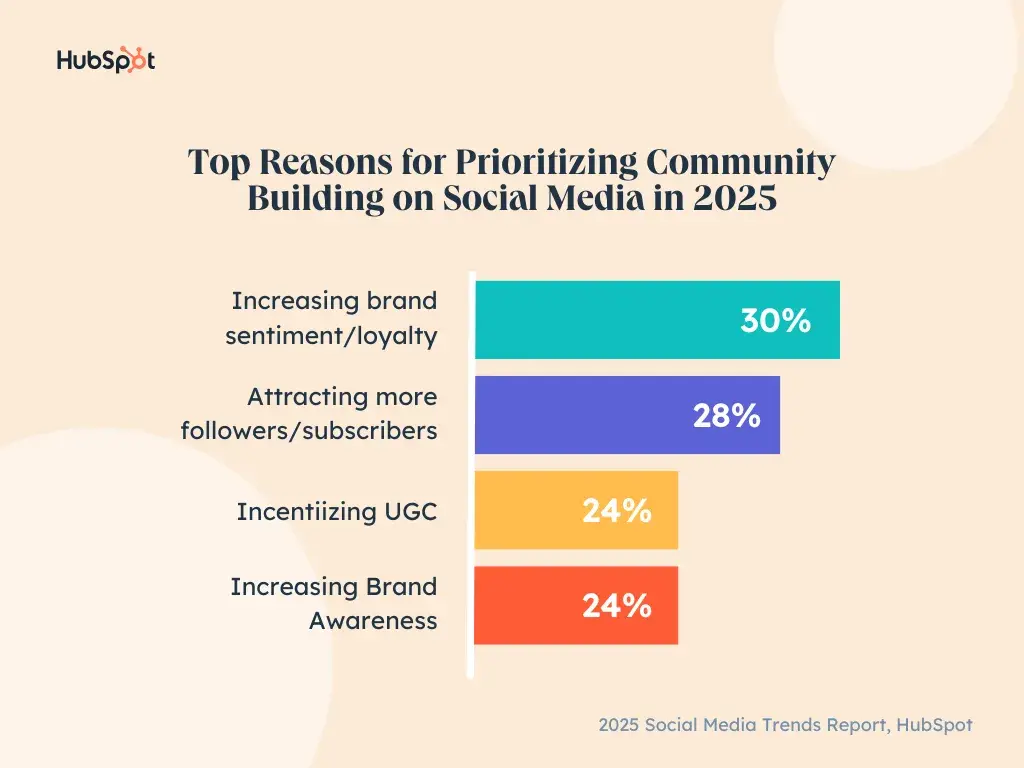- Trend 1: The Power of Local SEO and Hyperlocal Marketing for Small Businesses
- Trend 2: Affordable and Effective Social Media Strategies for Small Businesses
- Trend 3: Email Marketing and Building Direct Customer Relationships for Small Businesses
- Trend 4: Content Marketing on a Budget for Small Businesses
- Trend 5: Leveraging Digital Tools and Automation for Small Business Marketing Efficiency
- Key Takeaways
- Frequently Asked Questions (FAQs)
Marketing as a small business in 2025 is a different beast than it was even a few years ago. Growing economic pressures, rising ad costs, and a saturated digital landscape all mean that small businesses must now think even more strategically about their marketing than before.
Whether you’re a small team of one or two, or have a few more marketers on hand to support your business growth, there are several trends that could help you stay ahead of the pack in 2025.
Trend 1: The Power of Local SEO and Hyperlocal Marketing for Small Businesses
In 2025, local SEO isn’t a nice-to-have — it should be an essential part of your long-term marketing strategy. Consumers are increasingly searching for “near me” businesses while browsing on their mobile devices, and search engines are increasingly favoring businesses with strong, local relevance. Nearly a third of Americans look up information about local businesses online at least once a day, so it’s vital that your business is in the running to be found by those users.
Investing in hyperlocal marketing means getting the basics right: Starting with accurate NAP (Name, Address, Phone Number) listings online, especially on your Google Business Profile, is essential. Optimizing your website for localized keywords that include your city or town, or creating location-specific landing pages, can be helpful in driving organic traffic to your business online. Using structured data markup on your site can also help your business to appear in local search results pages and maps.
For businesses using digital advertising, hyperlocal targeting can go a step further with ads being served to specific neighborhoods via geofencing. Combining this approach with intent-based targeting can help you serve ads to customers who are ready to convert in your target locations. This is an especially strong strategy to use if you’re running a brick and mortar business.
Don’t forget about reviews, too: Recent reports suggest that over 83% of customers use Google to search for local business reviews, per Bright Local’s 2025 Local Consumer Survey. Responding to any reviews that come in, regardless of where, is an important way to build trust with both search engines and customers.
Other key stats from the same survey:
- 89% of U.S. consumers were more likely to use a business that responded to reviews.
- 83% of consumers use Google Reviews to research businesses.
- 48% of U.S. adults use local news outlets as sources for local business reviews.
Trend 2: Affordable and Effective Social Media Strategies for Small Businesses
Outside of managing your own website with an effective SEO strategy, social media remains one of the best small business marketing avenues in 2025, but it’s important to remember that not every platform will offer the same kind of return.
For most small to medium businesses, Instagram, TikTok, and Facebook continue to provide the best return on investment (ROI), particularly when your content is tailored to each audience. The most cost-effective way to produce content for these platforms as a small business is repurposing where possible. For instance, turning product ads into reels or a carousel ad on Facebook or Instagram means that you can maximize the shelf-life of your creative.
Short-form content is still the best performing in 2025, with most social media platforms prioritizing quick, engaging clips that can entertain or inform your audience. Livestreams also offer you the opportunity to connect with and build your community, with real-time interaction that increases trust with new and potential customers.
User-generated content (UGC) is also a powerful tool for small businesses. Encourage customers to tag your business in their content or share their genuine reviews of your products or services. Resharing this content can also naturally integrate into your existing content calendar, helping you stay visible and relevant across social platforms.
Download our Creative Holiday Playbook to learn more on how to optimize your ads
Not only that, but this approach fosters community for long-term success in a way that chasing virality doesn’t. Directly engaging with your customers through responding to comments and sharing customer posts increases engagement and sustained growth.

Source: Hubspot Social Media Report 2025
Even for those working on a limited budget, social media can be very effective, both paid and organic. Users in the middle of the sales funnel, with awareness of your brand but not quite at a purchase decision, are often the best group to target with paid social ads. Many small businesses can see an average of ROI of around $5 for every dollar spent on social advertising.
Social media marketing stats you should know in 2025:
- 78% of marketers said that social media has become consumers’ preferred customer service channel.
- 52% of marketers use funny content as part of their strategy, followed by relatable content, and then behind-the-scenes content.
- Facebook remains the most popular social media network worldwide, followed by YouTube and Instagram.
- For younger audiences, TikTok is now being used as a search engine, with 77% of Gen Z TikTok users using the platform for product discoverability.
Trend 3: Email Marketing and Building Direct Customer Relationships for Small Businesses
Email marketing has stood the test of time as one of the most powerful tools in small business marketing. With direct access to your audience, there are no algorithms to worry about, but you have to get it right to be effective. In 2025, that means personalization and segmentation.
With over half of consumers saying that marketing emails impact their purchase decisions, tailoring your email content to customer behavior and preferences can make a significant impact. You can speak to your customers directly by breaking them into relevant groups like past purchasers, first-time site visitors, or abandoned cart users to see better open rates, improved click-through rates, and more conversions. Using smart automation tools can support this even further, without needing a large marketing team manually programming it all.
Messaging is still the most important part of any successful email marketing campaign, whether you’re using automation or not. Educational content, seasonal offers, and new product announcements should all be shared with a personal feeling and provide real value to your customers. Including first names, location information, or purchase history insights can make these emails feel highly tailored to the individual recipient.
Think about how you can organically grow your email marketing list. Discounts for first-time signups are a great strategy for product-based businesses, along with giveaways. Embedding sign-up forms throughout your site is also useful for capturing this data and starting a lead nurturing process that targets your users directly in their inbox.
2025 email marketing statistics you should know:
- Email marketing sees an average ROI of $42 for every $1.
- 81% of businesses say that email drives customer acquisition.
Trend 4: Content Marketing on a Budget for Small Businesses
Content in any form continues to be a vital part of all effective digital marketing strategies, for businesses big and small, when it comes to attracting, educating, and converting customers. How-to guides, behind-the-scenes views, and customer stories are still some of the most successful pieces of content that resonate with both new and existing customers.
Creating without a large budget, though, is still a challenge for many small businesses. Planning and repurposing existing content can help combat some of these issues: For instance, a blog post could become a video script, while an ad could be turned into an organic social post or an email callout. AI-driven copy and image generators are now some of the most powerful tools for helping businesses repurpose this content and streamline the whole process. In 2025, 67% of small businesses are using AI tools for their content marketing, and this number will only continue to grow.
When it comes to sharing your newly-created content, both owned and paid channels can be effective. Social channels like Instagram and TikTok are ideal for short-form visual content, while written content is best on owned platforms like your website in the form of blogs and newsletters. Not only does this provide a home for your written content, but you can also benefit from SEO growth over time.
Discoverability is crucial for a successful SEO strategy, and content is a critical part of supporting this. Even low-budget content should be optimized for both users and search engines, with focused keyword research, optimized titles and descriptions, image alt text, and internal linking. Alongside any local SEO you may be including, these basic SEO steps are essential for giving your content the best chance of being found and ranked in search engine results pages (SERPs).
But, remember the most important factor — at the heart of any good business content, you should be telling the story of your why, what, and how. People want to connect with people, not a faceless business, so every piece of content should be tied back to your brand’s mission and vision, along with providing real-life stories of your customers and how your products or services help them solve a specific problem.
Insights from the Content Marketing Institute’s 2025 research shows that:
- 1 in 3 marketers have a scalable approach to content marketing.
- 54% cited lack of resources as the biggest challenge to content creation.
- Only 19% of B2B marketers are regularly using AI as part of their content workflow.
Trend 5: Leveraging Digital Tools and Automation for Small Business Marketing Efficiency
Time is often one of the biggest barriers to entry when it comes to small business digital marketing, but using the right tools to support your goals means you’ll get back some of that time, while also exploring new avenues for growth online.
From social media schedulers to AI writing assistants and drag-and-drop landing page builders, there are endless tools out there to help you and your team move quickly and efficiently. Automating repetitive tasks like sending customer emails, advertising optimization and budget management, reporting, or even running A/B tests on your ad creative can all free up time for your team to focus more on the big picture strategy.
AI tools are revolutionizing small business marketing and can give you a competitive edge that was previously only available to larger enterprises. CRM systems to consolidate customer data, track behavior, and manage outreach can be leveraged alongside AI tools to better target your customers and personalize every interaction they have with your business.
Analyzing performance has also become easier. Real-time dashboards that integrate data from various sources like your ads, website data, email, and social media channels mean that you can make fast, data-informed decisions that impact your bottom line.
Key stats around using the right tools that you should know:
- Only 23% of marketers are confident that they’re tracking the right metrics.
- 80% of marketers are looking to reduce time spent on repetitive tasks by using AI tools.
Key Takeaways
Small business marketing in 2025 is all about working smarter, not harder. Local SEO, combined with focused content marketing and social media marketing strategies, can capture the attention of local, high-intent customers while building long-term relationships. Email marketing remains one of the most cost effective methods of reaching middle-of-the-funnel prospects as a small business. Incorporating AI tools into the mix can offer you a strategic advantage that many of your competitors are not yet experiencing.
Frequently Asked Questions (FAQs)
What are the most effective digital marketing channels for small businesses in 2025?
Local SEO and email, along with social platforms like TikTok and Instagram, are the most effective digital marketing channels for small businesses in 2025.
How much should a small business spend on their digital marketing?
A typical small business will spend, on average, 7-10% of their revenue on marketing every year.
What are some common digital marketing mistakes small businesses should avoid?
Businesses who try to capture traffic from every platform often end up spreading themselves too thin. Instead, focused attention should be paid to a handful of channels. Neglecting basic SEO on your website and not paying attention to mobile optimization are also big issues that many small businesses overlook.
How can small businesses compete with larger companies online?
Authentic storytelling and niche targeting are the best ways to compete against larger businesses online. Remember, people buy from people — one of the biggest advantages of being a small business is the personal attention you can pay your customers in a way that a large enterprise struggles to replicate.
What are the key metrics for measuring success in small business digital marketing?
Conversion rate, customer acquisition cost (CAC), return on ad spend (ROAS), email open and clicks, and engagement rates are some of the most critical metrics to track.



